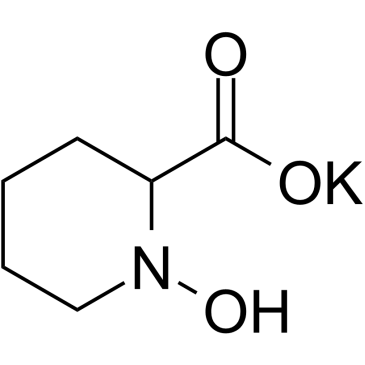N-Hydroxypipecolic acid potassium
Modify Date: 2024-01-14 12:33:58

N-Hydroxypipecolic acid potassium structure
|
Common Name | N-Hydroxypipecolic acid potassium | ||
|---|---|---|---|---|
| CAS Number | 2253632-01-6 | Molecular Weight | 183.25 | |
| Density | N/A | Boiling Point | N/A | |
| Molecular Formula | C6H10KNO3 | Melting Point | N/A | |
| MSDS | N/A | Flash Point | N/A | |
Use of N-Hydroxypipecolic acid potassiumN-Hydroxypipecolic acid potassium (1-Hydroxy-2-piperidinecarboxylic acid potassium), a plant metabolite and a systemic acquired resistance (SAR) regulator, orchestrates SAR establishment in concert with the immune signal salicylic acid. N-Hydroxypipecolic acid potassium accumulates systemically in the plant foliage in response to pathogen attack. N-Hydroxypipecolic acid potassium induces SAR to bacterial and oomycete infection[1][2][3]. |
| Name | N-Hydroxypipecolic acid potassium |
|---|
| Description | N-Hydroxypipecolic acid potassium (1-Hydroxy-2-piperidinecarboxylic acid potassium), a plant metabolite and a systemic acquired resistance (SAR) regulator, orchestrates SAR establishment in concert with the immune signal salicylic acid. N-Hydroxypipecolic acid potassium accumulates systemically in the plant foliage in response to pathogen attack. N-Hydroxypipecolic acid potassium induces SAR to bacterial and oomycete infection[1][2][3]. |
|---|---|
| Related Catalog | |
| In Vitro | The mode of action of N-Hydroxypipecolic acid potassium in SAR involves direct induction of SAR gene expression, signal amplification, priming for enhanced defense activation and positive interplay with salicylic acid signaling to ensure elevated plant immunity. Flavin-dependent-monooxygenase1 (FMO1) functions downstream of Pip by hydroxylating Pip to generate N-Hydroxypipecolic acid potassium[1][3]. |
| References |
| Molecular Formula | C6H10KNO3 |
|---|---|
| Molecular Weight | 183.25 |